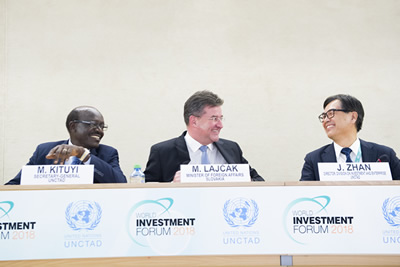
A new UNCTAD-hosted portal aims to gather best practices to help plug the trillion-dollar annual gap in financing for the Sustainable Development Goals.
Meeting the ambition set by the 2030 Agenda for Sustainable Development means bridging a massive financing gap of at least $2.5 trillion a year. A new online portal hosted by UNCTAD aims to energize efforts to hit the target.
Launched on 25 October at UNCTAD’s World Investment Forum, the portal was the brainchild of Slovakia’s Minister of Foreign and European Affairs Miroslav Lajcák during his 12-month term as President of the UN General Assembly from September 2017 to September 2018.
“Today marks the culmination of many months of effort by my colleagues, member states and the private sector to provide a practical tool to boost financing for the Sustainable Development Goals,” Mr. Lajcák said at the World Investment Forum, which runs from 22-26 October at the United Nations’ European hub in Geneva, Switzerland.
“During my presidency, I made it my mission to find a useful and lasting solution to one of the most pressing questions around the Sustainable Development Goals. Namely, how to combine public and private resources in a meaningful way.”
The 17 Sustainable Development Goals (SDGs) form the core of the 2030 Agenda, which seeks to leverage new partnerships to curb poverty, improve health and protect the Planet.
UNCTAD estimates the shortfall in financing to achieve the SDGs at $2.5 trillion per year in developing countries alone.
While governments and the public sector will continue to play a key financing role, particularly in the delivery of essential public services, there is greater scope for business to engage in financing many areas of the SDGs to help close the gap. The challenge is how to channel private sector investment to SDG-relevant sectors – including infrastructure, clean energy, water and sanitation, health, or education – as well as to enhance the risk-return profiles of new investments and generate lasting impact on the ground.
Besides UNCTAD. Mr. Lajcák’s initiative brought together a range of other UN organizations, including the UN Development Programme and UN Environment, as well as the world body’s business grouping the Global Compact, and the World Economic Forum, International Chamber of Commerce, insurance giant Aviva, and a host of other public and private sector organizations.
“There is a wealth of momentum, talent and innovation but it is often fragmented and undersold. We realized that it needs to be in one place so that people can share best practices and learn from each other. These can inspire future action and offer countries a practical resource for mobilizing finance for their own SDG targets,” said Mr. Mr. Lajcák.
The portal – dubbed the “toolbox” – pools the solutions that came out of a high-level event on “Financing for SDGs – Breaking the Bottlenecks of Investment, from Policy to Impact”, which was convened by Mr. Lajcák in June 2018.
UNCTAD Secretary-General Mukhisa Kituyi was among the senior officials involved in the process and, at the portal’s launch, he hailed Mr. Lajcák’s leadership.
“When you came up with the initiative of creating a common repository of best practice in reaching the community of financing for development, it was a very innovative idea,” Dr. Kituyi said.
He underscored the timing of the launch, given that the World Investment Forum has drawn thousands of financial and development experts.
“The focus of this week’s activities is looking for ways to galvanize financing, funding and investment into the SDG agenda. For us to have an opportunity not to be static, not be reinventing the wheel at every stage, but to have a one stop shop for ideas, implementation, best practices and thought leadership, gives us a unique advantage,” he said.
The toolbox acts as living repository of existing and future global public and private initiatives and, through future interaction with stakeholders, it provides an accessible platform for countries and financial actors to explore solutions to the challenge of financing the SDGs.
In its initial form, contains 43 concrete, tried and tested programmes and policy initiatives that policymakers can adapt and adopt. The initiatives in the toolbox are organized along the four elements of a framework set out originally in UNCTAD’s World Investment Report 2014: leadership and institutional setting; mobilizing funds; channeling funds to SDG sectors; and ensuring sustainable impact on the ground.